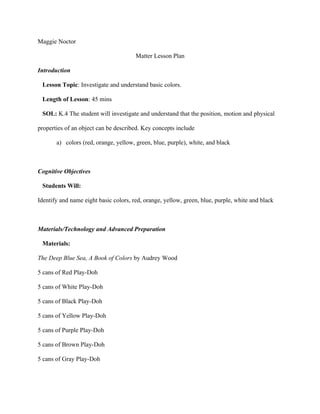
Matter lesson plan
- 1. Maggie Noctor Matter Lesson Plan Introduction Lesson Topic: Investigate and understand basic colors. Length of Lesson: 45 mins SOL: K.4 The student will investigate and understand that the position, motion and physical properties of an object can be described. Key concepts include a) colors (red, orange, yellow, green, blue, purple), white, and black Cognitive Objectives Students Will: Identify and name eight basic colors, red, orange, yellow, green, blue, purple, white and black Materials/Technology and Advanced Preparation Materials: The Deep Blue Sea, A Book of Colors by Audrey Wood 5 cans of Red Play-Doh 5 cans of White Play-Doh 5 cans of Black Play-Doh 5 cans of Yellow Play-Doh 5 cans of Purple Play-Doh 5 cans of Brown Play-Doh 5 cans of Gray Play-Doh
- 2. 5 cans of Orange Play-Doh 5 cans of Green Play-Doh 5 cans of Blue Play-Doh 20 sheets of cardboard per student (around 8” by 8”) 8 pieces of different color paper Advanced Preparation: 1. Prepare bags of Play-Doh for tables 2. Put each can of Play-Doh into a plastic zip-lock bag 3. Label bag with color name 4. Put one bag of each color in a group until you have 5 groups with ten colors each 5. Write color name on coordinating piece of colored paper, large enough for class to see Teaching and Learning Sequence Introduction/Anticipatory Set: • Ask students to quietly walk to reading circle and sit • Take The Deep Blue Sea, A Book of Colors book from front desk with you • Read The Deep Blue Sea, A Book of Colors by Audrey Wood • Ask students about the different colors mentioned in the book “What were some of the colors used in the book?” • Make sure that students recall all ten colors (blue, red, green, brown, purple, orange, black, yellow, white and grey) • If a color is not mentioned help students by flipping to that page and asking, what color the objects are on that page
- 3. • Have students quietly walk back to their tables Lesson Development: • Distribute bags of Play-Doh to each table, each table should have the ten different colors of Play-Doh (blue, red, brown, green, purple, orange, black, yellow, white and grey) • Pass out one sheet of cardboard per student • Tell students that today they will be creating images from the book we just read. • Show how to press Play-doh against the piece of paper, for a 3-D effect not on top of the paper (this way the trees are not falling over, the Play-doh just leans on the paper). Also show how to construct/mold the Play-doh. • While walking around to ensure students don’t need help, reread story slowly to students • Make sure to read slow enough that students have enough time to construct the objects, also take this time to look for comprehension as students are using the correct color for each object. • Allow students to create all the following objects: blue sea, red rick, green tree, brown nut, purple parrot, orange butterfly, black spot, yellow sun, white cloud, grey cloud. • Then have students put the Play-doh back into bags and collect bags as well as cardboard Closure: • While collecting and cleaning up Play-doh, review eight major colors. • Hold up one color of construction paper with labeled name of color • Ask class for the name of the color • After correct identification ask class for other objects, either in the room or else where that are usually that color • Repeat for the rest of the seven labeled colored pieces of paper
- 4. • Explain to students that we use colors to describe objects everyday Homework: None Assessment: Formative: • Listen to answers given during the review of colors used in the book The Deep Blue Sea. Are the students naming actual colors from the book or can they not recall any? • Watch while students create their Play-Doh model; are they using the correct color as read from the book? Do they look confused or wait to choose their color after a classmate has helped? Summative: • Have students at end of the lesson name the name of the colors as a class while holding up the colored piece of construction paper with color name label on it, watch for students who still look confused. • For the next eight days review color names by having a day designated for that color, students should wear the corresponding color or bring in an object from home each day that shows the color of the day. When taking roll place a check by the students name if they have completed the task or showed understanding by wearing or bringing the correct color. References: Jeremy, Brunaccioni. (2010-1996). Deep Blue Sea: A Book of Colors Lesson Plan. http://www2.scholastic.com/browse/lessonplan.jsp?id=1005.